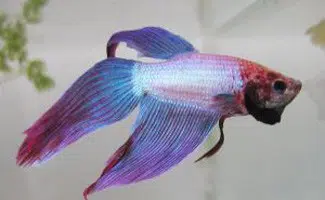When you purchase through links on our site, we may earn a commission. Here’s how it works.

Where Does the Siamese fighting fish come from?
The Siamese fighting fish and the betta fish are one and the same; in fact the name “Betta fish” comes from the scientific term “Betta splendens.” The genus name of this fish comes from the Malay term ikan bettah, Malay is a language used throughout Malaysia and Indonesia. The origin of the Siamese fighting fish can be found in the pla-kad or trey krem fish that is native to the rice paddies of Malaysia, Cambodia and Thailand. These wild ancestors of the Beta fish are not one and the same but they are the wild roots of this incredibly beautiful fish.
What is the Siamese fighting fish?
The Siamese fighting fish is generally recognized, even by less experienced individuals as being a brightly colored fish known for its long and flowing fins and the aggressive nature of males of the species. This amazingly colored fish grows to approximately two inches long and comes in a number of varieties; however, it is interesting to note that naturally the Betta splendens is a brown or less brilliant green color which is certainly not as awe-inspiring as the brighter colors achieved through selective breeding. These fish are known by scientists for being a member of the gourami fish family, a variety of fish that are known for being freshwater perch-like fish that are native to Asia. There are approximately fifty individual fish that fall within the Betta genus; however, the most recognized species is the Betta splendens that is commonly found in pet stores worldwide. The Betta splendens lives around two to five years when kept in captivity and feed on a carnivorous diet.
What Do Siamese fighting fish eat?
Because Siamese fighting fish are for the most part carnivorous surface feeders they naturally feed upon mosquito larvae, insects, crustaceans and zooplankton that can be found on the surface of the water in their natural habitat. When kept in captivity, however, these fish mostly feed on specially formulated Betta pellets which consist of a combination of elements including: fish meal, bloodworms, shrimp meal, brine shrimp, wheat flour and vitamins to ensure health. For those fish lovers who prefer not to feed prepared pellets however, the Betta fish will also eat frozen of living daphnia, mosquito larvae, bloodworms and brine shrimp.
Why is the Siamese fighting fish called the Siamese fighting fish?
Siam, which is now referred to as Thailand, were the original collectors of the Betta fish and records exist to indicate that this collection of the Betta splendens began before the 19th century. While in nature these fish generally avoid extended “fighting” displays with one another, with these encounters lasting only a few minutes, the Siamese began to breed these fish specifically to develop this fighting instinct. Over time the fighting instinct within these fish was developed to the point that they became a large source of entertainment. Events would be held in which large amounts of money or other material possessions would be wagered on fights between Siamese fighting fish and backing the fish that backed down first resulted in losing what was wagered. These fish fighting events became so popular that the king of Siam saw an opportunity to profit and he began licensing and collecting Betta fish. In 1840 the King of Siam gifted a few of his fighting fish that had been bred specifically for fighting instinct to a man who then gave the fish to Dr Theodor Cantor. Cantor, a medical scientist, was fascinated by the fish and some years later he would go on to write about them in an article referring to them as Macropodus Pugnax, a name that he would later find was already attributed to another species. Cantor would later rename this species Betta splendens.
The Colors of the Siamese fighting fish

Interestingly when discussing the colors of the Siamese fighting fish it is noted the actual color itself is not a result of skin pigmentation and rather a result of refraction within a layer of crystals in the “skin” known as guanine crystals. It is from this that certain colors of the Beta fish appear to change as light shines upon the fish or when the fish is viewed from a different angle. Cross breeding specific colors of Betta fish has resulted in a number of color varieties and more recently breeders have also been able to obtain color patterns as well! Breeding specific fish has resulted in the production of not only newer color combinations but also in new patterning of the fish including such patterns as “marble” and “butterfly.” Sometimes these new color combinations or patterns are developed by cross breeding specific Betta species with the Betta splendens.
Male versus Female Betta Fish
Color
The brightest and showiest of the Siamese fighting fish is always the male of the species which is why the male Betta fish always outsells the female in pet stores and aquarium supply shops. This fact derives from the history of the Siamese fighting fish since it is the males and not the females of the species that have these aggressive displays with one another. Since the females have no need for an aggressive display in nature they tend to have much duller and more subdued color tones. Over time though, breeders have begun to breed female Siamese fighting fish in a range of brighter colors as well.
Fins
The fins of the Siamese fighting fish are certainly one of the most awe-inspiring aspects of this fish; however, these incredible fins are only found on males of the species. The female Betta fish has no need to develop such showy find to attract a mate and intimidate other fish of the same-sex and as a result, the male is always a more desired fish when it comes to keeping the Betta fish as a pet.
The Tail Shape of the Betta Fish
While color is one of the things that amateur Betta fish lovers are drawn to, another feature of these colorful fish that garners much attention is the tail shape. There is a wide array of tail shapes in the Siamese fighting fish and each, combined with color, makes every individual fish unique.
Dragon Scale Betta Fish
The dragon scale Betta fish has a tail that is made up of scales that are one solid color. The color of these scales tends to be mostly white however, which makes this Betta fish a poor choice if you are looking for a bright and colorful fish.
Veiltail Betta Fish
The veiltail Betta fish has a tail that has only two rays and that is not symmetrical. The veiltail Betta has a tail that looks similar to a woman’s draped veil hence the name.
Rosetail Betta Fish
The rosetail Betta fish has a tail that is similar to the half-moon Betta’s tail; however, it has much more fin material and as such it tends to overlap and look like the petals of a rose.
Half-Moon Betta Fish
The half-moon Betta fish has a large tail fin that appears as a large circle segment that approximates 180 degrees, this shape is similar to a half-moon shape, hence the name.
Crowntail Betta Fish
The crowntail Betta fish is also known as a fringetail Betta fish and is recognized for having extended spiny rays that are jagged or frilled.
Halfsun Betta Fish
The halfsun Betta fish has a combtail appearance; however, they have an anal fin that points at 180 degrees like the half-moon Betta.
Delta Tail
The delta tail Betta fish has a tail that resembles that of the half-moon but has a smaller span and sharper edges.
Short-finned Fighting Style Betta
The short-finned fighting style Betta fish is simply known for having extremely short fins in comparison to other varieties of Betta fish like the veiltail.
Double-tail Betta Fish
The double-tail Betta fish has a tail that is split in two giving it the appearance of having two individual tails. The dorsal fin of the double-tail Betta fish is quite long in comparison to that of other styles of Betta.
Which Betta Fish Tail Style is the Best?
When choosing a Betta fish, some people try to learn which trail style is best. As it happens there is no “best” when it comes to tail style so much as there is a best choice for your needs. Depending upon what you need from your Betta fish you can choose from any variety of tail styles. Since Betta’s are no longer used for fighting the length of fins and tails has little bearing unless you plan on cross breeding Betta’s to create your own style of Betta fish. For most people the deciding factor in picking their Siamese fighting fish is deciding which fish style they most like the look of, this includes the tail design, fin shape and length and color.
What is it Like to Own a Betta Fish?
Owning a Siamese fighting fish is similar to owning any other fish; however, there are a few rules that should be followed. For example two male Betta’s should not be kept in the same enclosure because their territoriality will lead to fighting. This aggressive behavior generally starts with the puffing out of their gill covers to make themselves appear more intimidating. This type of behavior can also be a sign of a Betta fish trying to impress a potential mate as well; however, the difference is fairly obvious since it depends upon whether the male is confronted with a male or a female companion. A common misconception about this gill flaring activity is that it is limited to male Betta fish only but this is not the case. Females of the species will also flare their gills at other females; this flaring serves a similar function in females as they try to establish their position in the pecking order of the community. While both males and females use this display tactic it is true that the males of the species are more aggressive by nature than the females.
Puffing out of the gills is not the only display that these fish present. The Siamese fighting fish also displays horizontal bars on their skin when they are frightened or particularly stressed although this change is rarely noticed because while it is seen in females and young male Betta’s, the majority of Betta owners choose to own the mature males because of their splendid colors and impressive fins and tails.
How to Keep Siamese Fighting Fish
For the most part anyone who ventures to keep a Betta fish understands that males of the species should be kept alone. When multiple males of the species are placed within a single area they will become territorial and will fight, this fighting can result in injury or death to one or both of the fish. Keeping females and males together is also not recommended. If you are breeding your Betta’s the male and female must obviously be placed in a tank together; however, immediately after breeding the female should be taken out of the tank as the two will begin fighting. Multiple female Betta’s can be kept in a large tank together but they should not be placed in significantly large groups, groups of females should be kept to three or less fish. Females of the species are less aggressive than males which is why, when placed in small groups, in big tanks, with plenty of hiding places; these Betta’s will not fight or kill each other.
Sometimes owners of Siamese fighting fish want to keep their male Betta in a larger tank with other fish that have similar requirements in terms of water temperature and alkalinity. Males can be placed in large tanks with other community fish; however, much research should be done prior to doing this because not all fish are compatible with the male Betta. Fish that resemble other male Betta’s in color or in the shape and length of their fins are likely to get harassed or confronted by the male Betta fish. It is also possible for the male Betta to become the target of other aggressive fish within the aquarium community and have their long fins nipped or get seriously injured. The difficulty in finding compatible tank mates for this particular species of fish is why the males of the species are generally kept alone.
How Big of a Tank Should a Betta Fish Have?
If you are looking for a tank for your Siamese fighting fish then you have undoubtedly seen the small little cups that pet stores use to house their fish. These cups are used because it is an affordable way to make sure that the males of the species do not fight and the females of the species do not mate with the males. While the Siamese fighting fish are capable of surviving in these particularly small areas they are not happy in them for extended periods of time and as they become unhappy their colors will become dim and they will become lethargic. When bringing your own Betta fish home it is important to use the rule of thumb of twelve gallons. On average a male Siamese fighting fish is happiest with a tank that holds at least 12 gallons of water. This allows the fish to grow to its full potential while also having plenty of room to swim and hide in ornamental caves or plant life. While 12 gallons is the preferable minimum size for the fish, many people choose to use smaller desktop like aquariums in which their fish still thrive.
Is the Siamese Fighting Fish for You?
If you have been thinking about getting a Siamese fighting fish there are plenty of reasons why you should pick one of these colorful fish; however, there are also some reasons why they may not be the ideal pet for you. If you are looking for a fish that will fit in to a large community aquarium with other brightly colored fish, then the male Betta is not for you. If you are looking for a fish to keep in a relatively small aquarium, the Betta fish is probably not for you and if you are looking for a fish that loves an aerated tank with few hiding places, then the Betta is definitely not for you. If, however, you are looking for a beautifully colored and solitary fish then the male Betta fish may be your man!
Tagged With: Fish

